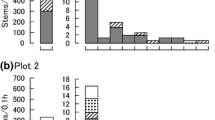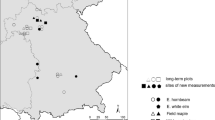Abstract
Key message
Density was more important in shaping crown structure than neighbor species identity. Both species showed high crown plasticity at alternative levels, which may explain species coexistence in mixed broadleaved forests with functionally similar species.
Abstract
Understanding crown response to local competition is essential to predicting stand development in mixed stands. We analyzed data from an 8-year-old field experimental plantation mixing two species according to a crossed gradient of density and species proportion to quantify the effect of a broad range of local neighborhood conditions on the development of young trees at multiple crown levels. We used Fagus sylvatica and Acer pseudoplatanus, as two model deciduous species. They are considered functionally equivalent at the young stages, but with contrasting architectural patterns. For both species: (1) changes in density explained more of the variation on crown development than species proportion (2) much of the effect of competition was accounted for by variables at the stem level, while branch and leaf development within crowns were not directly altered by competition. Both species were able to modify their crowns at the stem level to compete with intra- and inter-specific neighbors: Acer and Fagus were taller with a highest proportion of Fagus as neighbors; Fagus displayed a lower crown base when the proportion of Fagus decreased, while Acer had a lower crown base when the proportion of Fagus around it increased. Both species showed common shapes in allometric relationships but contrasting responses at alternative crown levels. Acer exhibited broader intra-specific variation in its height–diameter relationship and in its crown length, while Fagus displayed higher individual variation of branch development and leaf area than Acer. This study demonstrates that differences in crown development strategy of each species in response to changes in local neighborhood conditions are an important factor in maintaining species coexistence in broadleaved forests and designing mixtures that persist over time.






Similar content being viewed by others
References
Ameztegui A, Coll L (2011) Tree dynamics and co-existence in the montane–sub-alpine ecotone: the role of different light-induced strategies. J Veg Sci 22:1049–1061. doi:10.1111/j.1654-1103.2011.01316.x
Antin C, Pélissier R, Vincent G, Couteron P (2013) Crown allometries are less responsive than stem allometry to tree size and habitat variations in an Indian monsoon forest. Trees 27:1485–1495. doi:10.1007/s00468-013-0896-7
Barthélémy D, Caraglio Y (2007) Plant architecture: a dynamic, multilevel and comprehensive approach to plant form, structure and ontogeny. Ann Bot 99:375–407. doi:10.1093/aob/mcl260
Bell AD (1991) Plant form: an illustrated guide to flowering plant morphology. Oxford University Press, Oxford
Coates KD, Canham CD, LePage PT (2009) Above- versus below-ground competitive effects and responses of a guild of temperate tree species. J Ecol 97:118–130
Collet C, Fournier M, Ningre F et al (2011) Growth and posture control strategies in Fagus sylvatica and Acer pseudoplatanus saplings in response to canopy disturbance. Ann Bot 107:1345–1353. doi:10.1093/aob/mcr058
Collet C, Ningre F, Barbeito I et al (2014) Response of tree growth and species coexistence to density and species evenness in a young forest plantation with two competing species. Ann Bot 113:711–719. doi:10.1093/aob/mct285
Davies O, Pommerening A (2008) The contribution of structural indices to the modelling of Sitka spruce (Picea sitchensis) and birch (Betula spp.) crowns. For Ecol Manag 256:68–77. doi:10.1016/j.foreco.2008.03.052
Deleuze C, Herve J-C, Colin F, Ribeyrolles L (1996) Modelling crown shape of Picea abies : spacing effects. Can J For Res 26:1957–1966
Dieler J, Pretzsch H (2013) Morphological plasticity of European beech (Fagus sylvatica L.) in pure and mixed-species stands. For Ecol Manag 295:97–108. doi:10.1016/j.foreco.2012.12.049
Fournier M, Dlouhá J, Jaouen G, Almeras T (2013) Integrative biomechanics for tree ecology: beyond wood density and strength. J Exp Bot ert279. doi: 10.1093/jxb/ert279
Frech A, Leuschner C, Hagemeier M, Holscher D (2003) Neighbor-dependent canopy dimensions of ash, hornbeam, and lime in a species-rich mixed forest (Hainich National Park, Thuringia). Forstwissenchaftlisches Cent 122:22–35
Harja D, Vincent G, Mulia R, Noordwijk M (2012) Tree shape plasticity in relation to crown exposure. Trees 26:1275–1285. doi:10.1007/s00468-012-0703-x
Hein S, Mäkinen H, Yue C, Kohnle U (2007) Modelling branch characteristics of Norway spruce from wide spacings in Germany. For Ecol Manag 242:155–164. doi:10.1016/j.foreco.2007.01.014
Hein S, Collet C, Ammer C et al (2009) A review of growth and stand dynamics of Acer pseudoplatanus L. in Europe: implications for silviculture. Forestry 82:361–385. doi:10.1093/forestry/cpn043
Huang S, Meng SX, Yang Y (2009) Assessing the goodness of fit of forest models estimated by nonlinear mixed-model methods. Can J For Res 39:2418–2436
Ilomäki S, Nikinmaa E, Mäkelä A (2003) Crown rise due to competition drives biomass allocation in silver birch. Can J For Res 33:2395–2404. doi:10.1139/x03-164
Kaitaniemi P, Lintunen A (2008) Precision of allometric scaling equations for trees can be improved by including the effect of ecological interactions. Trees 22:579–584. doi:10.1007/s00468-008-0218-7
Kaitaniemi P, Lintunen A (2010) Neighbor identity and competition influence tree growth in Scots pine, Siberian larch, and silver birch. Ann For Sci 67:604. doi:10.1051/forest/2010017
Kawamura K (2010) A conceptual framework for the study of modular responses to local environmental heterogeneity within the plant crown and a review of related concepts. Ecol Res 25:733–744. doi:10.1007/s11284-009-0688-0
Lang AC, Härdtle W, Baruffol M et al (2012) Mechanisms promoting tree species co-existence: experimental evidence with saplings of subtropical forest ecosystems of China. J Veg Sci 23:837–846. doi:10.1111/j.1654-1103.2012.01403.x
Lines ER, Zavala MA, Purves DW, Coomes DA (2012) Predictable changes in aboveground allometry of trees along gradients of temperature, aridity and competition. Glob Ecol Biogeogr 21:1017–1028. doi:10.1111/j.1466-8238.2011.00746.x
Lintunen A, Kaitaniemi P (2010) Responses of crown architecture in Betula pendula to competition are dependent on the species of neighbouring trees. Trees 24:411–424. doi:10.1007/s00468-010-0409-x
Lintunen A, Sievänen R, Kaitaniemi P, Perttunen J (2011) Models of 3D crown structure for Scots pine (Pinus sylvestris) and silver birch (Betula pendula) grown in mixed forest. Can J For Res 41:1779–1794. doi:10.1139/x11-092
Mäkelä A, Vanninen P (1998) Impacts of size and competition on tree form and distribution of aboveground biomass in Scots pine. Can J For Res 28:216–227. doi:10.1139/x97-199
Mäkinen H, Colin F (1999) Predicting the number, death, and self-pruning of branches in Scots pine. Can J For Res 29:1225–1236. doi:10.1139/x99-065
Medhurst JL, Beadle CL (2001) Crown structure and leaf area index development in thinned and unthinned Eucalyptus nitens plantations. Tree Physiol 21:989–999. doi:10.1093/treephys/21.12-13.989
Muukkonen P (2007) Generalized allometric volume and biomass equations for some tree species in Europe. Eur J For Res 126:157–166. doi:10.1007/s10342-007-0168-4
Näslund M (1937) Skogsförsöksanstaltens gallringsförsök i tallskog. Medd Stat Skogsförsöksanst 29:1–169 (in Swedish)
Nicolini E, Chanson B, Bonne F (2001) Stem growth and epicormic branch formation in understorey beech trees (Fagus sylvatica L.). Ann Bot 87:737–750. doi:10.1006/anbo.2001.1398
Osada N (2006) Crown development in a pioneer tree, Rhus trichocarpa, in relation to the structure and growth of individual branches. New Phytol 172:667–678. doi:10.1111/j.1469-8137.2006.01857.x
Parish R, Nigh GD, Antos JA (2008) Allometry and size structure of trees in two ancient snow forests in coastal British Columbia. Can J For Res 38:278–288. doi:10.1139/X07-172
Petriţan AM, von Lüpke B, Petriţan IC (2009) Influence of light availability on growth, leaf morphology and plant architecture of beech (Fagus sylvatica L.), maple (Acer pseudoplatanus L.) and ash (Fraxinus excelsior L.) saplings. Eur J For Res 128:61–74. doi:10.1007/s10342-008-0239-1
Pretzsch H, Dieler J (2012) Evidence of variant intra- and interspecific scaling of tree crown structure and relevance for allometric theory. Oecologia 169:637–649. doi:10.1007/s00442-011-2240-5
Purves DW, Lichstein JW, Pacala SW (2007) Crown plasticity and competition for canopy space: a new spatially implicit model parameterized for 250 North American tree species. PLoS One 2:e870. doi:10.1371/journal.pone.0000870
Rouvinen S, Kuuluvainen T (1997) Structure and asymmetry of tree crowns in relation to local competition in a natural mature Scots pine forest. Can J For Res 27:890–902. doi:10.1139/x97-012
Schneider CA, Rasband WS, Eliceiri KW (2012) NIH image to image J: 25 years of image analysis. Nat Methods 9:671–675. doi:10.1038/nmeth.2089
Schröter M, Härdtle W, von Oheimb G (2012) Crown plasticity and neighborhood interactions of European beech (Fagus sylvatica L.) in an old-growth forest. Eur J For Res 131:787–798. doi:10.1007/s10342-011-0552-y
Sumida A, Terazawa I, Togashi A, Komiyama A (2002) Spatial arrangement of branches in relation to slope and neighbourhood competition. Ann Bot 89:301–310. doi:10.1093/aob/mcf042
Thorpe HC, Astrup R, Trowbridge A, Coates KD (2010) Competition and tree crowns: a neighborhood analysis of three boreal tree species. For Ecol Manag 259:1586–1596. doi:10.1016/j.foreco.2010.01.035
Vanclay JK (2006) Experiment designs to evaluate inter- and intra-specific interactions in mixed plantings of forest trees. For Ecol Manag 233:366–374. doi:10.1016/j.foreco.2006.05.034
Vieilledent G, Courbaud B, Kunstler G et al (2010) Individual variability in tree allometry determines light resource allocation in forest ecosystems: a hierarchical Bayesian approach. Oecologia 163:759–773. doi:10.1007/s00442-010-1581-9
Wagner S, Collet C, Madsen P et al (2010) Beech regeneration research: from ecological to silvicultural aspects. For Ecol Manag 259:2172–2182. doi:10.1016/j.foreco.2010.02.029
Weiskittel AR (2003) Alterations in Douglas-fir crown structure, morphology, and dynamics imposed by the Swiss needle cast disease in the Oregon Coast Range. Thesis
Weiskittel AR, Maguire D, Monserud RA (2007) Response of branch growth and mortality to silvicultural treatments in coastal Douglas-fir plantations: implications for predicting tree growth
Weiskittel AR, Seymour RS, Hofmeyer PV, Kershaw JA Jr (2010) Modelling primary branch frequency and size for five conifer species in Maine, USA. For Ecol Manag 259:1912–1921. doi:10.1016/j.foreco.2010.01.052
Zuur AF, Ieno EN, Walker N et al (2009) Mixed Effects Models and Extensions in Ecology with R, vol 1. Springer, Berlin
Acknowledgments
We thank C. Richter and A. Piboule (Office National des Forêts) for designing and installing the experimental site. Funding was provided by Region Lorraine (project “Jeune Equipe 2005”), Office National des Forêts (“ModelFor” project) and INRA (project “Forêts mélangées” from the ECOGer programme). The UMR 1092 LERFoB is supported by a grant overseen by the French National Research Agency (ANR) as part of the “Investissements d’Avenir” program (ANR-11-LABX-0002-01, Lab of Excellence ARBRE).
Conflict of interest
The authors declare that they have no conflict of interest.
Author information
Authors and Affiliations
Corresponding author
Additional information
Communicated by R. Matyssek.
Appendices
Appendices
Relationship between S brGU (the sum of cross-sectional areas at the base of each GU) and the cross-sectional areas at GU base (SbaseGU) and GU distal end (SendGU) for both species (Eq. 5; Table 2; Sample 3; Table 1). Note that a single trendline is shown for both species because they are almost identical
Rights and permissions
About this article
Cite this article
Barbeito, I., Collet, C. & Ningre, F. Crown responses to neighbor density and species identity in a young mixed deciduous stand. Trees 28, 1751–1765 (2014). https://doi.org/10.1007/s00468-014-1082-2
Received:
Revised:
Accepted:
Published:
Issue Date:
DOI: https://doi.org/10.1007/s00468-014-1082-2








